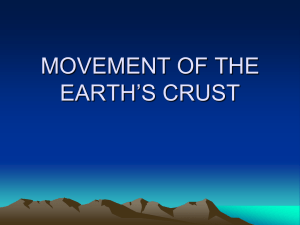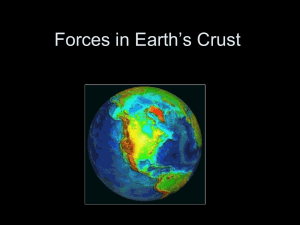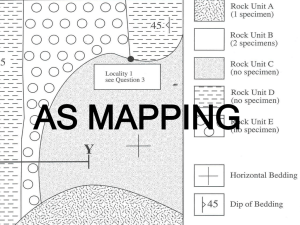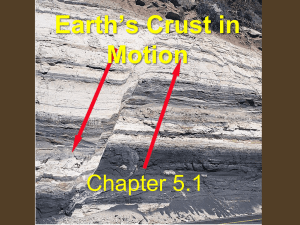Geologic Structures
advertisement
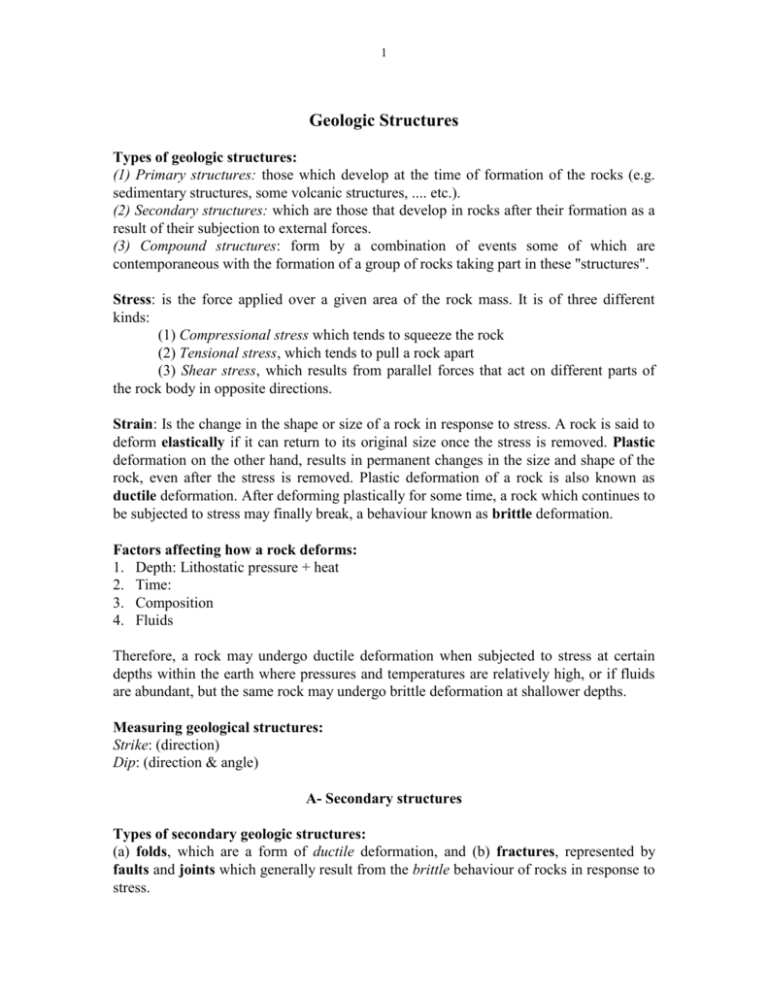
1 Geologic Structures Types of geologic structures: (1) Primary structures: those which develop at the time of formation of the rocks (e.g. sedimentary structures, some volcanic structures, .... etc.). (2) Secondary structures: which are those that develop in rocks after their formation as a result of their subjection to external forces. (3) Compound structures: form by a combination of events some of which are contemporaneous with the formation of a group of rocks taking part in these "structures". Stress: is the force applied over a given area of the rock mass. It is of three different kinds: (1) Compressional stress which tends to squeeze the rock (2) Tensional stress, which tends to pull a rock apart (3) Shear stress, which results from parallel forces that act on different parts of the rock body in opposite directions. Strain: Is the change in the shape or size of a rock in response to stress. A rock is said to deform elastically if it can return to its original size once the stress is removed. Plastic deformation on the other hand, results in permanent changes in the size and shape of the rock, even after the stress is removed. Plastic deformation of a rock is also known as ductile deformation. After deforming plastically for some time, a rock which continues to be subjected to stress may finally break, a behaviour known as brittle deformation. Factors affecting how a rock deforms: 1. Depth: Lithostatic pressure + heat 2. Time: 3. Composition 4. Fluids Therefore, a rock may undergo ductile deformation when subjected to stress at certain depths within the earth where pressures and temperatures are relatively high, or if fluids are abundant, but the same rock may undergo brittle deformation at shallower depths. Measuring geological structures: Strike: (direction) Dip: (direction & angle) A- Secondary structures Types of secondary geologic structures: (a) folds, which are a form of ductile deformation, and (b) fractures, represented by faults and joints which generally result from the brittle behaviour of rocks in response to stress. 2 I- Folds Folds are bends or flexures in the earth's crust, and can therefore be identified by a change in the amount and/or direction of dip of rock units. Most folds result from the ductile deformation of rocks when subjected to compressional or shear stress. In order to understand and classify folds, we must study their forms and shapes, and be able to describe them. The following definitions are therefore essential for the description of a fold: 1- Hinge line: Is the line of maximum curvature on a folded surface. The hinge line almost always coincides with the axis of the fold defined as a line lying in the plane that bisects a fold into two equal parts. 2- The axial plane is an imaginary plane dividing the fold into two equal parts known as limbs. It is therefore the plane which includes all hinge lines for different beds affected by the same fold. 3- The crest of a fold can be considered the highest point on a folded surface. The trough is the lowest point on a folded surface. 4- The interlimb angle: Is the angle between two limbs of the same fold. It is measured in a plane perpendicular to that of the fold axis. 5- The angle of plunge of a fold is the angle between the fold axis and the horizontal plane, measured in a vertical plane. The direction of plunge of a fold is the direction in which the fold axis dips into the ground from the horizontal plane. 6- The median surface: Is the surface that passes through points where the fold limb changes its curvature from concave to convex. 7- The amplitude of a fold: is the vertical distance between the median surface and the fold hinge, both taken on the same surface of the same folded unit. 8- The wavelength of a fold system is the distance between two consecutive crests or troughs taken on the same folded surface. Classification of folds Folds may be classified based on the direction of dip of their limbs, the inclination of their axial planes, the value of their interlimb angle, their plunge, and their general shape and effects on the thickness of the folded layers. In order to describe a fold correctly, one may have to use more that one of these classifications; e.g. recumbent anticline, open syncline, tight plunging anticline, .... etc. (see below). (a) Classification based on the direction of dip of the limbs: When both limbs of a fold dip away from the fold axis, the fold is called an antiform. If both limbs dip towards the fold axis, the fold is known as a synform. If the relative ages of the folded units are known, such that the oldest units occur in the core of the antiform, the antiform is called "anticline". Similarly, if the youngest units occur in the "center" of a synformal structure, it is known as a syncline (Fig. 1). 3 A monocline is a single step-like bend in a rock unit, and is often caused by vertical displacement. A dome consists of uparched rocks that dip in all directions away from the central point. A basin is a downwarp in which the layers dip in all directions from all sides towards the centre (Fig. 2). A fold is described as isoclinal if both limbs dip in the same direction at the same angle (Fig. 3). (b) Classification based on the inclination of the axial plane: (Fig. 4) A symmetrical (or upright) fold is one in which the axial plane bisects the fold (and is vertical). If the axial plane is inclined at an angle < 45° (measured from the vertical plane), the fold is said to be inclined. If the angle of inclination of the axial plane is > 45° (from the vertical plane), then both limbs of the fold will dip in the same direction, and the fold is known as inverted or overturned. If the axial plane is horizontal, the fold is known as recumbent. (c) Classification based on the value of the interlimb angle (Fig. 5): (1) Open folds: those with an interlimb angle > 70°, (2) Closed folds: with interlimb angles between 30 and 70°, (3) Tight folds: with interlimb angles < 30°, (4) Isoclinal folds: have zero interlimb angles. II- Faults A fault is a fracture in the earth's rock units along which there has been an observable amount of movement and displacement. Unlike folds which form predominantly by compressional stress, faults result from either tension, compression or shear. In order to correctly describe a fault, it is essential to understand its components: 1- The fault plane: Is the plane of dislocation or fracture along which displacement has occurred. The fault plane therefore separates one or more rock units into two blocks. 2- The Hanging wall and footwall blocks: If the fault plane is not vertical, then the block lying on top of the fault plane is known as the hanging wall block, whereas that lying below this plane is known as the footwall block. 3- The downthrown and upthrown blocks: The downthrown block is the one that has moved downwards relative to the other block, whereas the upthrown block is that which registers an upward relative movement. 4- The Dip of the fault plane is the angle of inclination of the fault plane measured from the horizontal plane perpendicular to its strike. 6- Fault Throw: Is the vertical displacement of a fault. 8- Dip slip: Is the amount of displacement measured on the fault plane in the direction of its dip. 9- Strike slip: Is the amount of displacement measured on the fault plane in the direction of its strike. 10- Net slip: Is the total amount of displacement measured on the fault plane in the direction of movement. 4 N.B. In measuring the slip or throw of a fault, the displacement has to be measured using the same surface of the same unit affected by that fault. Types of Faults 1- Normal fault: Is a fault in which the hanging wall appears to have moved downwards relative to the footwall (i.e. downthrown block = hanging wall block). 2- Reverse fault: Is a fault in which the hanging wall appears to have moved upwards relative to the footwall (i.e. upthrown block = hanging wall block). Because the displacement in both normal and reverse faults occurs along the dip of the fault plane, they may be considered types of dip slip faults. 3- Thrust fault (or thrust): Is a reverse fault in which the fault plane is dipping at low angles (< 45°). Thrusts are very common in mountain chains (fold and thrust belts) where they are characterized by transporting older rocks on top of younger ones over long distances. 4- Strike slip (wrench, tear or transcurrent) fault: Is a fault in which the movement is horizontal along the strike of the fault plane. Strike slip faults are either dextral or sinistral. When viewed on end (Fig. 13), a dextral fault (also known as right lateral fault) is one in which the block on the observer's right hand side appears to have moved towards him, whereas a sinistral strike slip fault (also known as left lateral) is one in which the block on the observer's left hand side appears to have moved towards him. 5- Oblique slip fault: is one in which the displacement was both in the strike and dip directions (i.e. the displacement has strike and dip components). Keep in mind that an oblique slip fault can also be either normal or reverse. From this classification of faults, it can be seen that normal faults result predominantly from tensional stress, reverse faults and thrusts from compression (or shear), and strike slip faults from tension, compression or shear. Fault Associations and Fault Systems (Fig. 6) Faults often occur in groups. If two normal faults have parallel strikes and share the same downthrown block, a trough-like structure results which is known as a graben. A horst is an uplifted block bounded by two normal faults that strike parallel to each other (and which share the same upthrown block the horst). Grabens and horsts are common in areas of very early rifting (e.g. the East African Rift Valley). Step faults are several faults with parallel strikes and a repeated downthrow in the same direction giving the area an overall step - like appearance. They are common in rifted areas (e.g. on the flanks of the Red sea). Geomorphological features associated with faults: Fault planes often result in the exposure of units that erode easily along the fault trace resulting in the development of valleys or the control of stream flow. In other cases, faults cause the offset of streams, causing them to bend sharply when they intersect the fault plane. The topography may also be strongly influenced by faulting so that the fault plane 5 can be identified on the ground by a sudden and sharp change in elevation, known as a fault scarp. Recognition of movement along fault planes Movement along a fault plane can often be recognized by the following criteria: 1- Fault drag: where small - scale folding or warping of units takes place as a result of the dragging forces along the fault plane (Fig. 7). 2- Fault breccia and fault gouge: As a result of movement along the fault plane, rocks are often broken up into sharp angular pieces known as breccia. The fragments may be further crushed into powder - like material, known as fault gouge. 3- Slickensides: As a result of movement and friction along the fault plane, this plane may become highly polished or abraded with striations that are known as slickensides (Fig. 8). III- Joints Joints are fractures in the rocks characterized by no movement along their surfaces. Although most joints are secondary structures, some are primary, forming at the time of formation of the rocks. Types of joints 1- Columnar joints: Are joints that form in basalts. When the basaltic lava cools, it contracts giving rise to hexagonal shaped columns. 2- Mud cracks: Are joints that form in mud. As the mud loses its water, it contracts and cracks. 3- Secondary joints: Are joints that form in rocks as a result of their subjection to any form of stress (compression, tension or shear). Joints that are oriented in one direction approximately parallel to one another make up a joint set. Rocks often have more than one set of joints with different orientations, which may intersect, and are then known as joint systems (Fig. 9). Note that tensional stress usually results in one set of joints, whereas compression may form more than one set. 4- Sheet joints: Are joints that form in granitic rocks in deserts causing them to break into thin parallel sheets. These joints form when the rocks expand as a result of the rapid removal of the overlying rock cover, possibly due to faulting or quarrying. This process is called exfoliation. 6 B- Compound Structures Unconformities An unconformity is a surface (or contact) along which there was no fracturing (i.e. not a fault or joint) and which represents a break in the geologic record. An unconformity therefore indicates a lack of continuity of sedimentary deposition in an area, resulting in rocks of widely different ages occurring in contact with each other. Unconformities usually result from changes in the sedimentary history of an area, which may be due to vertical movements (e.g. uplift followed by erosion and deposition), deformation (also followed by deposition), changes in sea level (which may be due to climatic changes, among other things), ...etc. In many cases, unconformities represent a buried erosional surface. In such cases, erosion of the older units results in their fragmentation into smaller pieces. As soon as deposition resumes, these fragments may consolidate to form a rock known as breccia (if the fragments are angular) or conglomerate (if the fragments are rounded). Because the breccia or conglomerate occur at the base of the younger units lying on top of the unconformity surface, and because their fragments are derived from the units below this surface, the conglomerates or breccias are known as basal conglomerates or basal breccias. Types of unconformities (Fig. 10) 1- Angular unconformities: are those in which the angle of dip of the younger layers is different from that of the older ones. 2- Disconformities: are those in which the units above and below the unconformity surface are parallel to each other, but not continuous in deposition or age. 3- Nonconformities: are those in which plutonic or metamorphic rocks are covered by sedimentary or volcanic units. Geological Structures and Plate tectonics: All three types of plate boundaries are characterized by certain deformational (structural) features. The most intense deformation occurs in areas of continent - continent collision. Divergent boundaries: Mostly extensional structures; horsts, grabens, step faults, ... etc. Convergent boundaries: "Fold and thrust belts"; nappes (Fig. 11). Transform boundaries: Strike slip faults, en echelon faults Mountain building (Orogeny): Examples: Andes Rockies, Himalayas, Alps, Appalachians Basin & Range: Tetons Adirondacks 7 Vertical movements (Epeirogeny/ uplift) and Isostasy. Epeirogeny is the vertical movement of crustal blocks relative to sea level in a "nonmountain building" event. The term is rather vague and is almost obsolete! The simple "non-genetic" term uplift is more useful. Isostasy is the state of balance between extensive blocks of the earth's crust which rise to different levels and appear at the surface as mountain ranges, plateaus and plains. Applied to mountains (where the lighter continental crust overlying the denser mantle is quite thick), this concept dictates that the higher the mountain, the thicker the crust beneath it, or the deeper the "crustal root" of that mountain within the underlying mantle. Because the sialic material is less dense than sima, the gravitational attraction beneath mountain chains is much lower than that on the ocean floors (Fig. 12) Another important effect of isostasy is seen when material is eroded from a mountain, resulting in the rise of the crust - mantle boundary (the Moho) to compensate for the eroded material. This process is known as isostatic readjustment or isostatic rebound (Fig. 13). A good example of this process can be seen in parts of the Baltics, Arctic and the Great Lakes Region of North America. During the ice ages, these areas were covered by large ice caps which depressed the crust by as much as 200 to 300 meters. When the ice melted, the crust rebounded slowly, as evidenced by the occurrence of beach deposits at high elevations. Importance of studying geologic structures
